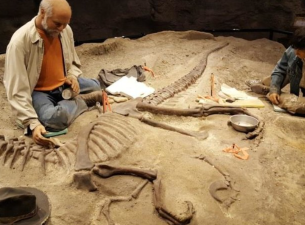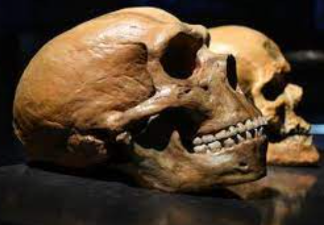Archaeology, through the excavation of ancient sites and artifacts, presents a tangible picture of human origins.
For example, at Olduvai Gorge in Africa, archaeologists have discovered numerous stone tools from early humans. Although crude in appearance, these tools represent the earliest manifestations of the wisdom and creativity of our ancestors. Studying these tools reveals our understanding of the lifestyles and technological capabilities of early humans.
Archaeology Reveals Chronological Clues to Human Origins
1. Fossil Dating
Archaeologists use radiocarbon dating and other methods to determine the age of ancient human fossils. For example, some early human fossils discovered in East Africa have been dated millions of years ago. This reveals that human origins were a long process spanning a vast timeframe.
With the continuous advancement of technology, more precise dating techniques, such as potassium-argon dating, can help us more accurately determine the age of even earlier human remains, further refining the timeline of human origins.
2. Stratigraphic Analysis
Strata are a valuable resource for archaeological excavations. Human activity at different times creates distinct layers of sedimentary deposits underground. Caves and sites inhabited by early humans often leave traces of their activities within their strata, such as stone tools and traces of fire.
By analyzing the relationship between strata and the materials they contain, archaeologists can determine the order in which different human activities occurred. For example, at a particular site, simpler chipped stone tools were found in the lower strata, while more refined polished stone tools appeared in the upper strata. This indicates the continuous development of human technology and provides a chronological clue for studying technological evolution during the origins of humanity.
Archaeology Provides Physical Evidence for Human Origins Research
- Archaeology, through the excavation of ancient sites and artifacts, presents a tangible picture of human origins. For example, at Olduvai Gorge in Africa, archaeologists have discovered numerous early human stone tools. Although crude in appearance, these stone tools represent the earliest manifestations of the wisdom and creativity of our ancestors. Studying these stone tools can help us understand the lifestyles and technological capabilities of early humans.
- In China, the Peking Man Site in Zhoukoudian, Beijing, is another important discovery. A wealth of fossils and remains have been unearthed here, providing us with a more direct understanding of the lives of Homo erectus. The Peking Man skull fossil and traces of fire use, among other discoveries, provide invaluable evidence for studying key stages in human evolution. These physical evidence are like slices of history, allowing us to travel back in time and witness the origins of humanity firsthand.
- Furthermore, archaeological discoveries of ancient hominins provide direct evidence of the course of human evolution. From the early Australopithecus to the later Homo habilis, Homo erectus, and finally Homo sapiens, fossils from each stage hold crucial information. The locations and stratigraphic relationships of these fossils provide a solid foundation for constructing the timeline and spatial distribution of human evolution.
Helping to Determine the Time and Location of Human Origins
- Archaeology has played a key role in determining the time and location of human origins. Africa has long been considered a key region for the origin of humanity, a view supported by numerous archaeological discoveries. The famous "Lucy" fossil was unearthed in Ethiopia's Afar region. "Lucy" belonged to the species Australopithecus afarensis and lived approximately 3.2 million years ago. Her discovery provides strong evidence for the origin of humanity in Africa, significantly pushing the timeline of human origins forward.
- At the same time, archaeologists have discovered numerous early human sites in other parts of Africa, ranging in age from millions to hundreds of thousands of years ago. Through analysis of these sites, including radiocarbon dating and paleomagnetic dating, the approximate timeframe of humanity's origins in Africa has gradually been clarified.
- Beyond Africa, several other regions have also seen important archaeological discoveries related to human origins. For example, at the Dmanisi site in Georgia, fossils of Homo erectus dating back approximately 1.8 million years have been discovered. This suggests that some populations were already active in Eurasia before humans left Africa, providing new insights into human migration and dispersal.

Unveiling the Lifestyle of Human Origins
Archaeology allows us to understand the lifestyle of humans during their origins. Early human dwellings varied widely in terms of living environment. At some cave sites, archaeologists have uncovered evidence of human use of natural caves as habitats. Cave interiors may show simple signs of fire use and the placement of stone tools, reflecting the life of humans at the time. Some open-air sites reveal the remains of simple human dwellings, such as huts made of branches and thatch. Although these structures may have long since decayed, analysis of the surrounding soil and related artifacts reveals their general form and function. Archaeological discoveries have also provided a wealth of information on diet. The study of stone tools reveals the hunting and gathering practices of early humans. Animal bones with cut marks indicate that humans began systematically hunting prey. Remains of plant seeds and fruits also demonstrate the importance of foraging in the diet. Furthermore, the discovery of fire remains underscores the crucial role of cooking in the development of the human diet. Fire not only cooked food but also altered its texture and nutritional value, contributing to the development of the human brain.






